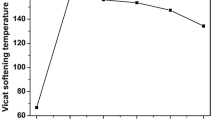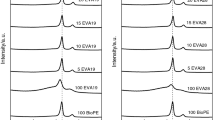Abstract
Tensile properties and thermal characteristics of blends made from linear low-density polyethylene (LLDPE) and polyvinyl alcohol (PVA) have been investigated. 3-(Trimethoxysilyl)propyl methacrylate (Si A174) was used as a coupling agent. The blends were melted and mixed using a Haake Rheomix at 150 °C and 50 rpm for 10 min. Results show that the incorporation of Si A174 resulted in the increase of the tensile strength and Young’s modulus but decrease in the elongation at break of the LLDPE/PVA blends. The crosslinked formation between LLDPE, PVA, and Si A174 was confirmed by decrease of melting temperature and degree of crystallinity as demonstrated by differential scanning calorimetry study.
Access provided by Autonomous University of Puebla. Download conference paper PDF
Similar content being viewed by others
Keywords
1 Introduction
In situ silane crosslinking technology in polyethylene has offered several advantages over chemical treatment and radiation methods. This technique has been used extensively as the insulation compounds on the electrical cable system ranging from underground to Aerial Bundle Cable network (Celina and George 1995). The improvement in properties of silane crosslinked polyethylene included process operation and production, mechanical properties, degradation stability, and resistance to creep.
The treatment of filler or polymer by silane coupling agent has been reviewed by different authors (Bengtsson and Oksman 2006; Prachaywarakorn et al. 2008). It is observed that, in general, the silane crosslink polyethylene consists of at least two stages. The first stage is grafted silane via its vinyl groups on polyethylene through radical reaction. The second stage is silane crosslinking reaction of resultant copolymer via the exposure to hot water with the presence of catalyst through hydrolysis and condensation reaction.
In our previous work (Ismail et al. 2009, 2010), we have reported the tensile and thermal properties of linear low-density polyethylene/poly(vinyl alcohol) (LLDPE/PVA) blends. Results indicated that in situ incorporation of maleic acid in LLDPE/PVA blends showed increases in the tensile strength and Young’s modulus but slightly decreases the elongation at break. In this work, 3-methacryloxypropyltrimethoxysilane was used to crosslink linear low-density polyethylene/poly(vinyl alcohol) blends while the polymers in the molten state. It is expected that formation of crosslinked network will be reflected on the tensile and thermal properties.
2 Materials and Methods
2.1 Materials
Poly(vinyl alcohol) with average molecular weight of 89,000–98,000 and 99+% hydrolyzed, 3-(trimethoxysilyl)propyl methacrylate (Si A174), and dicumyl peroxide (DCP) was obtained from Sigma-Aldrich (Malaysia) Sdn. Bhd. Linear low-density polyethylene (LLDPE) with melt mass flow rate (MFR) (190 °C/2.16 kg) 1.0 g/10 min and melting temperature of 123 °C was obtained from Polyethylene (Malaysia) Sdn. Bhd.
2.2 Mixing Procedure
The formulation of LLDPE/PVA blends with and without Si A174 is shown in Table 1. The preparation of blends was carried out in a Haake Rheomix Polydrive at temperature 150 °C and rotor speed of 50 rpm for about 10 min. The blends were mixed according to mixing sequence as shown in Table 2.
Sample of blends was compression molded in an electrically heated hydraulic press. Hot-press procedures involved preheating at 150 °C for 4 min followed by compressing for 4 min at the same temperature and subsequent cooling under pressure for 3 min.
2.3 Measurement of Tensile Properties
Tensile test was carried out according to ASTM D 638 using Instron 3366. A crosshead speed of 50 mm/min was used, and the test was performed at 25 °C. Tensile strength, Young’s modulus, and elongation at break were evaluated from the stress–strain data.
2.4 Differential Scanning Calorimetry
Differential scanning calorimetry (DSC) measurements of blends were carried out by using Perkin Elmer Pyris 1 DSC under nitrogen atmosphere. Each blend was first heated from 30 to 170 °C at heating rate 10 °C/min, annealed for 5 min at 170 °C, cooled from 170 to −50 °C at cooling rate 10 °C/min, and rescanned from −50 to 300 °C at heating rate 10 °C/min (second scan). The blend weight was 10 ± 0.5 mg. Thermal properties such as melting temperature (Tm), crystallization temperature (Tc), and heat of fusion (∆H) were determined from DSC thermograms.
3 Results and Discussion
3.1 Tensile Properties
Figure 1a, b shows the effect of PVA content on the tensile properties of LLDPE/PVA blends with and without Si A174. It is clear that the tensile strength and elongation at break of LLDPE/PVA blends without Si A174 decrease steadily with increasing PVA content, whereas Young’s modulus (Fig. 2) shows the opposite trend. This is due to the poor interfacial adhesion between two opposite polarity polymers and resulted in poor stress transfer between matrix and the dispersed phase. It is believed that PVA forms agglomerates due to strong intramolecular hydrogen bonds between the hydroxyl groups which resulted in poor dispersion and adhesion in the LLDPE particularly at higher PVA content (Ismail et al. 2009, 2010). But as Si A174 were added into LLDPE/PVA blends, the tensile strength and Young’s modulus of the blends increase with increasing PVA content, while the elongation at break shows the opposite trend. This is due to the ability of Si A174 to improve compatibility between the PVA and LLDPE through crosslink reaction. Figures 3 and 4 show the proposed reaction occurred between LLDPE and PVA with the presence of Si A174.
3.2 Thermal Properties
The crystallinity (Xc), melting endotherms, melt crystallization temperatures (Tc), and the melting peak temperatures of the blends from DSC analysis are summarized in Table 3. The lower melting temperature and degree of crystallinity in crosslinked LLDPE/PVA blends compared to blends without Si A174 may be related to the crosslinking network initiated during melt processing. The network structure makes the macromolecular LLDPE chain less flexible, lowering the Tc and making crystallization more difficult. Interestingly, the Tc of crosslinked LLDPE/PVA blends with ratios of 60/40 and 50/50 are close to that of the pure LLDPE. This result indicates that Si A174 enhances the compatibility between PVA and LLDPE.
4 Conclusions
The following conclusion can be drawn from this study:
-
i.
The presence of Si A174 has increased the tensile strength, elongation at break, and Young’s modulus of LLDPE/PVA blends.
-
ii.
The compatibility of the LLDPE/PVA blends is enhanced by depression of melting temperature.
References
Bengtsson, M., & Oksman, K. (2006). Silane crosslinked wood plastic composites: Processing and properties. Composites Science and Technology, 66, 2177–2186.
Celina, M., & George, G. A. (1995). Characterization and degradation studies of peroxide and crosslinked polyethylene. Polymer Degradation and Stability, 48, 297–312.
Ismail, H., Ahmad, Z., Nordin, R., & Rashid, A. R. (2009). Processibility and miscibility studies of uncompatibilized linear low density polyethylene/poly(vinyl alcohol) blends. Polymer Plastics Technology and Engineering, 48(1–7), 2009.
Ismail, H., Ahmad, Z., Nordin, R., & Rashid, A. R. (2010). Processability and miscibility studies of linear low density polyethylene/poly(vinyl alcohol) blends: In situ compatibilized with maleic acid. Iranian Polymer Journal, 19, 297–308.
Prachaywarakorn, J., Khunsumled, S., Thongpin, C., Kositchaiyong, A., & Sombatsompop, N. (2008). Effects of silane and MAPE coupling agents on the properties and interfacial adhesion of wood filled PVC/LLDPE blend. Journal of Applied Polymer Science, 108, 3523–3530.
Acknowledgements
One of the authors is thankful for the financial support from research grant of Universiti Teknologi MARA.
Author information
Authors and Affiliations
Corresponding author
Editor information
Editors and Affiliations
Rights and permissions
Copyright information
© 2018 Springer Nature Singapore Pte Ltd.
About this paper
Cite this paper
Nordin, R., Ismail, H., Ahmad, Z., Santiago, R. (2018). Tensile Properties and Thermal Characteristics of Linear Low-Density Polyethylene/Poly(Vinyl Alcohol) Blends Containing 3-(Trimethoxysilyl) Propyl Methacrylate. In: Saian, R., Abbas, M. (eds) Proceedings of the Second International Conference on the Future of ASEAN (ICoFA) 2017 – Volume 2. Springer, Singapore. https://doi.org/10.1007/978-981-10-8471-3_5
Download citation
DOI: https://doi.org/10.1007/978-981-10-8471-3_5
Published:
Publisher Name: Springer, Singapore
Print ISBN: 978-981-10-8470-6
Online ISBN: 978-981-10-8471-3
eBook Packages: Social SciencesSocial Sciences (R0)








